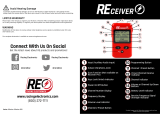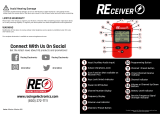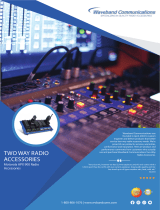
TECHNISONIC INDUSTRIES LIMITED
TDFM-9100 Operating Instructions TiL 13RE482 Rev. E
v
1 GENERAL DESCRIPTION B
1.1 INTRODUCTION ............................................................................................................. 1
1.2 DESCRIPTION ................................................................................................................ 1
1.3 MODEL VARIATION ....................................................................................................... 1
1.4 TECHNICAL CHARACTERISTICS ................................................................................. 3
2 OPERATING INSTRUCTIONS B
2.1 GENERAL ....................................................................................................................... 5
2.2 FRONT PANEL ............................................................................................................... 5
2.3 POWER SWITCH ............................................................................................................ 6
2.4 KNOB .............................................................................................................................. 6
2.5 SOFT KEYS AND HOME ................................................................................................ 6
2.6 BAND KEY ...................................................................................................................... 7
2.7 FUNC KEY ...................................................................................................................... 7
2.8 F1 – F4 KEYS ................................................................................................................. 8
2.9 MUP(4) AND MDN(7) KEYS (MEMORY UP AND DOWN KEYS) .................................. 9
2.10 UP(5) AND DOWN(8) KEYS ........................................................................................... 9
2.11 BRT(6) AND DIM(9) KEYS .............................................................................................. 9
2.12 ESW(0) KEY (ERGO SWITCH KEY) .............................................................................. 10
2.13 TSW(*) KEY (TOGGLE SWITCH KEY) .......................................................................... 10
2.14 DISPLAY ......................................................................................................................... 10
2.15 GENERAL OPERATION ................................................................................................. 10
2.16 CUSTOMER PROGRAMMING SOFTWARE (APX CPS
TM
) ........................................... 11
2.17 CONFIGURATION MENU ............................................................................................... 12
2.18 MAINTENANCE MENU ................................................................................................... 13
2.19 FRONT PANEL PROGRAMMING (FPP) MODE ........................................................... 15
2.20 PROGRAMMING CONSIDERATIONS ........................................................................... 17
2.21 BAND 3 ............................................................................................................................ 17
2.22 BANDS 4 AND 5 ............................................................................................................. 17
2.23 LATITUDE S200 SATCOM CONTROL .......................................................................... 17
2.24 LATITUDE S200 PTT MODE ......................................................................................... 17
2.25 LATITUDE S200 PHONE MODE .................................................................................... 19
WARRANTY .................................................................................................................... 20
1 Front Panel Controls – TDFM-9100 Transceiver ........................................................... 5
2 TDFM-9100 Function Menu ........................................................................................... 7
3 Programming Cable: “PC-9000” P/N 127499 ................................................................. 11
4 Encryption Keyloading Cable: “KVL-9000” P/N 127500 ................................................ 12
LIST OF TABLES
1 TDFM-9100 CTCSS/PL/TPL Tone vs Motorola PL Codes ............................................ 16
2 TDFM-9100 DCS/DPL Codes ........................................................................................ 16
TABLE OF CONTENTS
LIST OF FIGURES




























